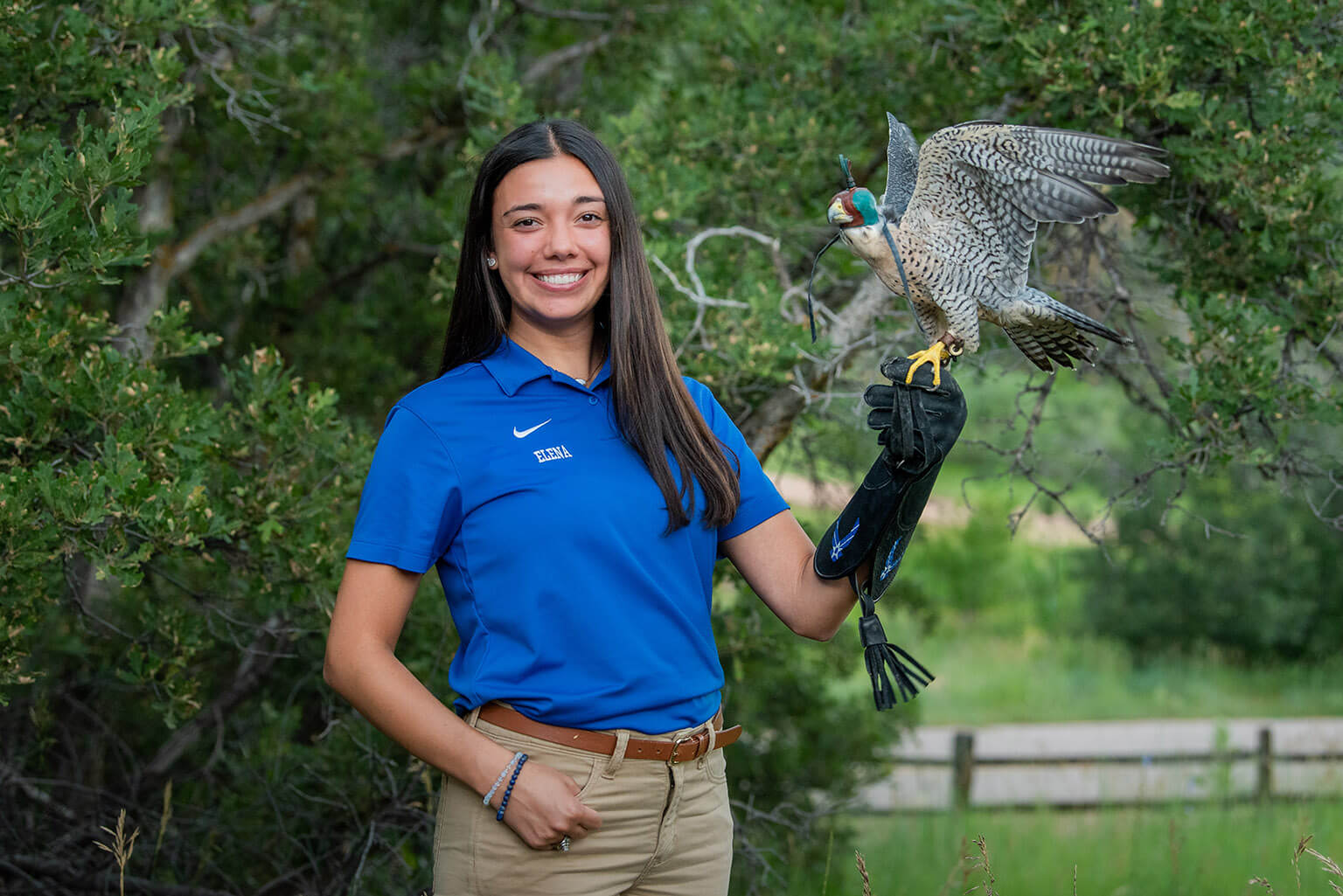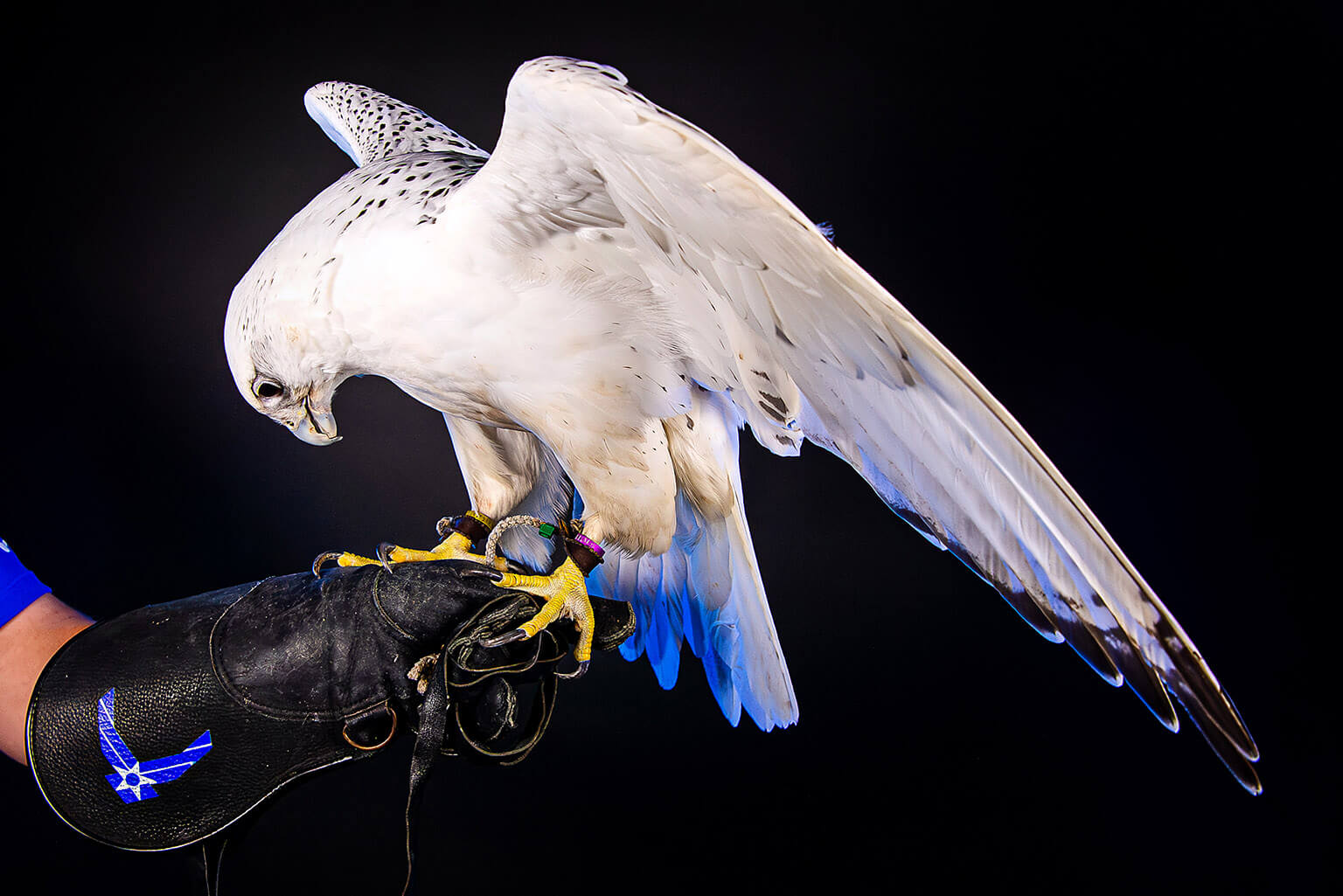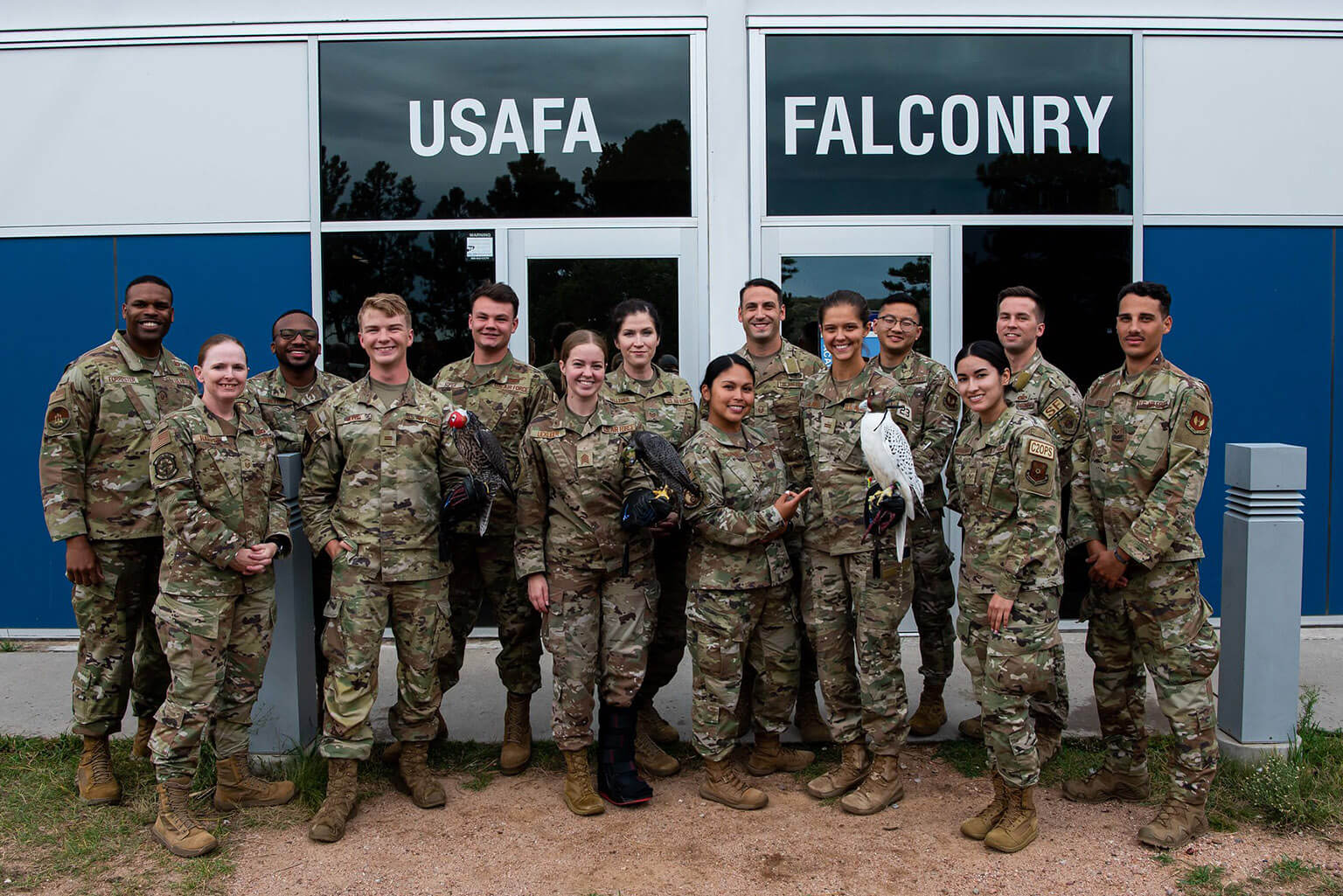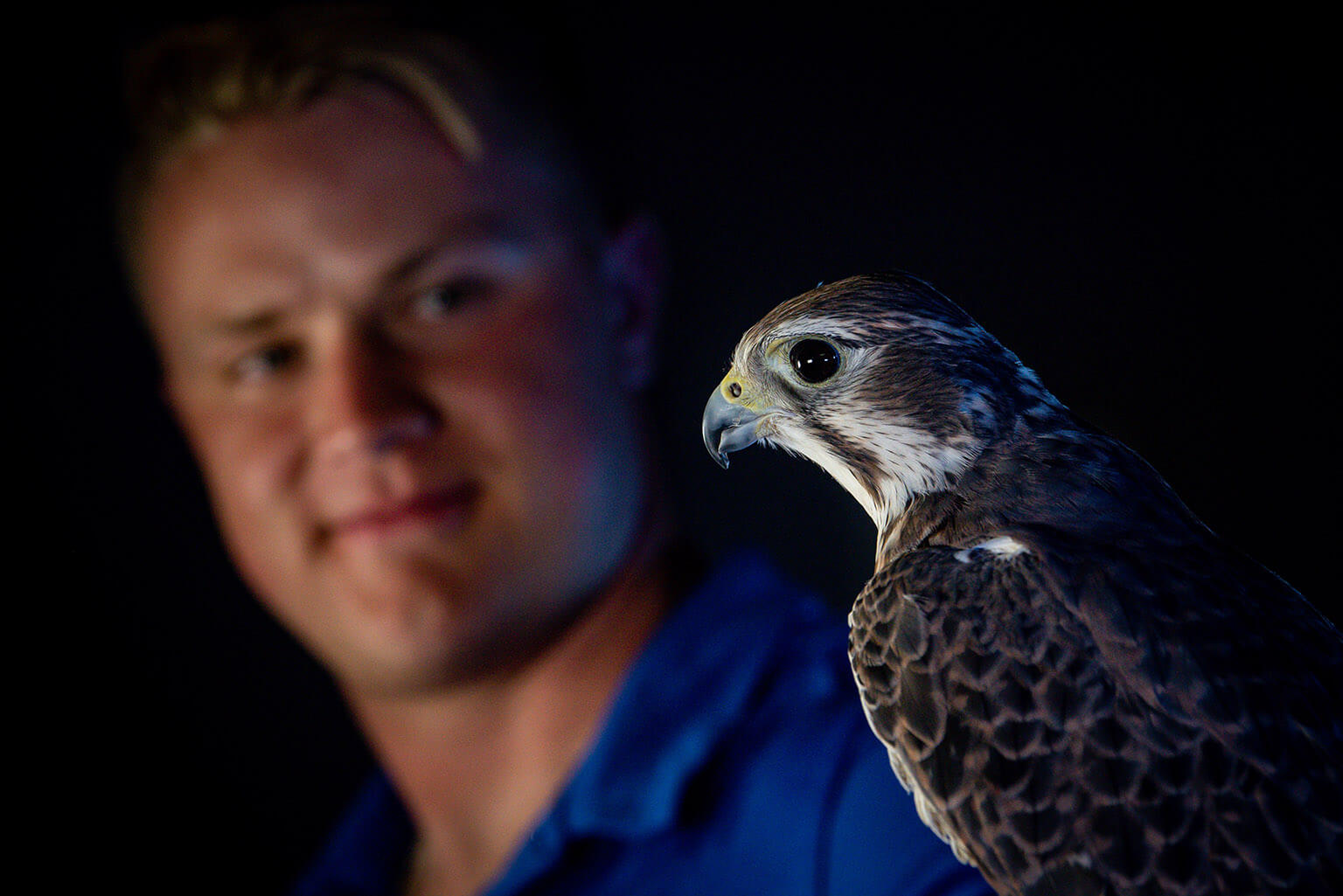‘Nature’s fighter pilots’ attract attention of future cadets
 U.S. Air Force Academy Cadet 1st Class Elena Castañeda, falconry cadet-in-charge, displays Kuzco, one of the Academy’s 11 falcons, Aug. 17, 2023. The 2-year-old anatum peregrine falcon came to the Academy with an injured wing in 2021. (U.S. Air Force photo by Rayna Schmidt)
U.S. Air Force Academy Cadet 1st Class Elena Castañeda, falconry cadet-in-charge, displays Kuzco, one of the Academy’s 11 falcons, Aug. 17, 2023. The 2-year-old anatum peregrine falcon came to the Academy with an injured wing in 2021. (U.S. Air Force photo by Rayna Schmidt)
By Randy Roughton
U.S. Air Force Academy Strategic Communications
U.S. AIR FORCE ACADEMY, Colo.– On Sept. 2, the falcons some call “nature’s fighter pilots” will once again entertain fans at a U.S. Air Force Academy football game. Three of the Academy’s 11 falcons fly at halftime at Falcon Stadium games, led by Ace, a 17-year-old Gyr-Saker hybrid falcon.
But fall football performances are only one part of the role of the U.S. Air Force Academy Falconry Team.
Outside of halftime performances, the falcons also interact with the public and young fans when the cadet falconers take them on the road. The club’s educational presentations generate questions about falconry but also discussion about the Academy and the steps needed for cadet admission.
Academy awareness through outreach initiatives
Academy falcons appeared for almost 350,000 people at educational demonstrations and special events nationwide in the past year, said Master Sgt. Mindy Bolton, one of the falconry non-commissioned officers in charge. The falcons have been Academy brand ambassadors since the first graduating class adopted the bird of prey as the mascot in 1955. A peregrine falcon named Mach 1 was the original mascot. Nova, a white-phased gyrfalcon, is the current official mascot.
“We reach a wide population of people through what we do, and we raise a lot of awareness for the Academy,” said Cadet 1st Class Elena Castañeda, falconry cadet-in-charge. “A lot of the people we talk to are aware of the military academies but not as aware of the Air Force Academy as its own separate institution. We teach people about what we do here as cadets and obviously what we do with the birds.”
 A U.S. Air Force Academy Falconry Team member holds Nova Aug. 23, 2023. The 3-year-old white-phase gyrfalcon succeeded Aurora as the Academy’s official mascot. (U.S. Air Force photo by Trevor Cokley)
A U.S. Air Force Academy Falconry Team member holds Nova Aug. 23, 2023. The 3-year-old white-phase gyrfalcon succeeded Aurora as the Academy’s official mascot. (U.S. Air Force photo by Trevor Cokley)
The Academy falconry team acquires birds in a few different ways. One way is by donations from local falconers and falconry programs due to a bird’s medical issues such as injured wings or heart conditions. Another method is by buying falcons from local falconers that breed the birds.
How cadets become falconers
Four new falconers join the team each year to replace the graduating seniors. The team looks for cadets who are personable, resilient and knowledgeable about the falcons. Selection is highly competitive. Additionally, cadets must pass the Colorado Department of Wildlife raptor licensing examination before joining the team. New team members begin training in January under the leadership of master falconer Sam Dollar, team leaders and more experienced upperclassmen.
Falconers’ duties and responsibilities
Cadet falconers’ duties include feeding the falcons, checking each bird’s health and condition daily, cleaning the mews, and maintaining equipment. They also interact with the birds regularly to get them accustomed to being handled. New falcons experience what some falconers call a “manning process” to get them accustomed to human handling and interacting with the public. They also learn to associate a falconer with a glove, hood, leash and pocket with food. But the typical falcon will never bond with a human like a dog or a cat would.
 Falconry cadets pose for a photo with members of the 12 Outstanding Airmen of the Year at the U.S. Air Force Academy Sept. 27, 2022. The falconry team participates in a wide variety of community events, sharing the Academy story with local schools and civic groups, as well as appearances at Academy sporting events, such as Falcon football. (U.S. Air Force photo by Trevor Cokley)
Falconry cadets pose for a photo with members of the 12 Outstanding Airmen of the Year at the U.S. Air Force Academy Sept. 27, 2022. The falconry team participates in a wide variety of community events, sharing the Academy story with local schools and civic groups, as well as appearances at Academy sporting events, such as Falcon football. (U.S. Air Force photo by Trevor Cokley)
Motivated by quail
“They’re entirely food-driven,” Castañeda said. “That’s how we keep them coming back. I like to tell people that I do the loving for my bird and I because [Karena] doesn’t necessarily love me like a dog would. But they can recognize faces and know we’re the people who will feed them.”
Falcons eat 10% of their body weight daily. Falconers at the Academy cut up quail because they do not want the birds to associate food with live or dead animals. The cadets remove any parts of the quail that could cause disease or infection. This helps to keep the birds focused on the lure. The lure is a beanbag on a rope and is used as a training and exercise tool.
In addition to feeding the falcons, the cadets also help Dollar trim the falcons’ beaks and talons.
“They do it themselves in the wild by filing on rocks, but we don’t have anything like that in their pens,” Castaneda said. “So, we just have a spa day.”
Flying high on game day
This time of year, the falcons are a major part of Air Force Academy football. The three flying demonstration falcons fly from a cadet falconer on the top of the press box to another falconer spinning a lure at midfield.
“When the bird gets that lure, they’re fed for the day,” said Cadet 1st Class Evan Komschlies, Ace’s falconer. “So even though it might seem like they’re giving the crowd a show, they’re really just laser-focused on that lure.”

U.S. Air Force Academy Falconry Team Cadet 1st Class Evan Komschlies displays Kara, a 6-year-old prairie falcon. Kara has a medical condition known as “stargazing syndrome” that causes her to tilt her head back and look upward or at odd angles. (U.S. Air Force Photo by Justin R. Pacheco)
See more photos of the U.S. Air Force Academy Falconry Team at Flickr.